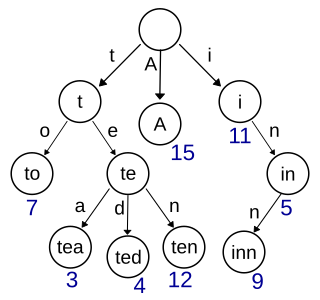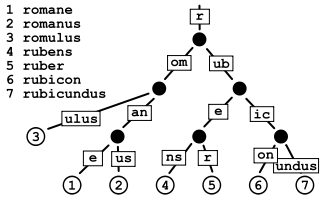
In computer science, a data structure is a data organization and storage format that is usually chosen for efficient access to data. More precisely, a data structure is a collection of data values, the relationships among them, and the functions or operations that can be applied to the data, i.e., it is an algebraic structure about data.

In computing, a hash table is a data structure that implements an associative array, also called a dictionary or simply map; an associative array is an abstract data type that maps keys to values. A hash table uses a hash function to compute an index, also called a hash code, into an array of buckets or slots, from which the desired value can be found. During lookup, the key is hashed and the resulting hash indicates where the corresponding value is stored. A map implemented by a hash table is called a hash map.

In computer science, a trie, also known as a digital tree or prefix tree, is a specialized search tree data structure used to store and retrieve strings from a dictionary or set. Unlike a binary search tree, nodes in a trie do not store their associated key. Instead, each node's position within the trie determines its associated key, with the connections between nodes defined by individual characters rather than the entire key.
In computer science, an associative array, map, symbol table, or dictionary is an abstract data type that stores a collection of pairs, such that each possible key appears at most once in the collection. In mathematical terms, an associative array is a function with finite domain. It supports 'lookup', 'remove', and 'insert' operations.
In computer science, a set is an abstract data type that can store unique values, without any particular order. It is a computer implementation of the mathematical concept of a finite set. Unlike most other collection types, rather than retrieving a specific element from a set, one typically tests a value for membership in a set.
In computer science, a Judy array is a data structure implementing a type of associative array with high performance and low memory usage. Unlike most other key-value stores, Judy arrays use no hashing, leverage compression on their keys, and can efficiently represent sparse data; that is, they may have large ranges of unassigned indices without greatly increasing memory usage or processing time. They are designed to remain efficient even on structures with sizes in the peta-element range, with performance scaling on the order of O(log n). Roughly speaking, Judy arrays are highly optimized 256-ary radix trees.
In computing, a persistent data structure or not ephemeral data structure is a data structure that always preserves the previous version of itself when it is modified. Such data structures are effectively immutable, as their operations do not (visibly) update the structure in-place, but instead always yield a new updated structure. The term was introduced in Driscoll, Sarnak, Sleator, and Tarjan's 1986 article.

In computer science, a radix tree is a data structure that represents a space-optimized trie in which each node that is the only child is merged with its parent. The result is that the number of children of every internal node is at most the radix r of the radix tree, where r = 2x for some integer x ≥ 1. Unlike regular trees, edges can be labeled with sequences of elements as well as single elements. This makes radix trees much more efficient for small sets and for sets of strings that share long prefixes.

In cryptography and computer science, a hash tree or Merkle tree is a tree in which every "leaf" node is labelled with the cryptographic hash of a data block, and every node that is not a leaf is labelled with the cryptographic hash of the labels of its child nodes. A hash tree allows efficient and secure verification of the contents of a large data structure. A hash tree is a generalization of a hash list and a hash chain.
In computer science, a ternary search tree is a type of trie where nodes are arranged in a manner similar to a binary search tree, but with up to three children rather than the binary tree's limit of two. Like other prefix trees, a ternary search tree can be used as an associative map structure with the ability for incremental string search. However, ternary search trees are more space efficient compared to standard prefix trees, at the cost of speed. Common applications for ternary search trees include spell-checking and auto-completion.
In computer science, hash trie can refer to:
Extendible hashing is a type of hash system which treats a hash as a bit string and uses a trie for bucket lookup. Because of the hierarchical nature of the system, re-hashing is an incremental operation. This means that time-sensitive applications are less affected by table growth than by standard full-table rehashes.
A prefix hash tree (PHT) is a distributed data structure that enables more sophisticated queries over a distributed hash table (DHT). The prefix hash tree uses the lookup interface of a DHT to construct a trie-based data structure that is both efficient, and resilient.
A hash array mapped trie (HAMT) is an implementation of an associative array that combines the characteristics of a hash table and an array mapped trie. It is a refined version of the more general notion of a hash tree.
In computer science, an x-fast trie is a data structure for storing integers from a bounded domain. It supports exact and predecessor or successor queries in time O(log log M), using O(n log M) space, where n is the number of stored values and M is the maximum value in the domain. The structure was proposed by Dan Willard in 1982, along with the more complicated y-fast trie, as a way to improve the space usage of van Emde Boas trees, while retaining the O(log log M) query time.
In computer science, a y-fast trie is a data structure for storing integers from a bounded domain. It supports exact and predecessor or successor queries in time O(log log M), using O(n) space, where n is the number of stored values and M is the maximum value in the domain. The structure was proposed by Dan Willard in 1982 to decrease the O(n log M) space used by an x-fast trie.
A concurrent hash-trie or Ctrie is a concurrent thread-safe lock-free implementation of a hash array mapped trie. It is used to implement the concurrent map abstraction. It has particularly scalable concurrent insert and remove operations and is memory-efficient. It is the first known concurrent data-structure that supports O(1), atomic, lock-free snapshots.
In computer science, hash tree may refer to:
The HAT-trie is a type of radix trie that uses array nodes to collect individual key–value pairs under radix nodes and hash buckets into an associative array. Unlike a simple hash table, HAT-tries store key–value in an ordered collection. The original inventors are Nikolas Askitis and Ranjan Sinha. Askitis & Zobel showed that building and accessing the HAT-trie key/value collection is considerably faster than other sorted access methods and is comparable to the array hash which is an unsorted collection. This is due to the cache-friendly nature of the data structure which attempts to group access to data in time and space into the 64 byte cache line size of the modern CPU.



